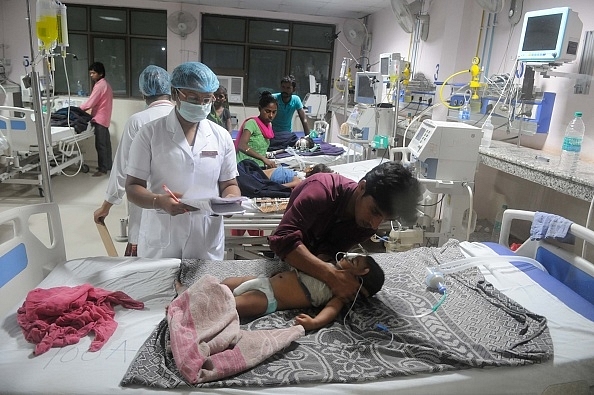Politics
Gorakhpur Tragedy: Most Children’s Deaths Not Due To Encephalitis; Hospital Records Show
- Of the first 30 deaths between 10 and 11 August, only five were due to acute encephalitis syndrome or AES and one was due to hepatic encephalopathy.

Children being looked after by medical staff at the encephalitis ward at BRD Medical Centre. (Deepak Gupta/Hindustan Times via GettyImages)
Most of the deaths of children at Gorakhpur’s BRD Medical College Hospital over the past five days are not due to encephalitis, the hospital’s own medical records reveal.
Over 70 children have died in just five days in the hospital in the Uttar Pradesh city and questions are being asked (and fingers pointed) about the cause of death.
The state government believes encephalitis – a long-time scourge in this part of the state – is the reason for the mounting death toll of children.
It has dismissed reports attributing some of the deaths to the temporary, but fatal, termination of liquid oxygen supplies at the hospital.
If the data available with the hospital is to be believed – Mint has a copy of the details – of the first 30 deaths that occurred on 10 and 11 August, only five were due to acute encephalitis syndrome or AES; one was due to hepatic encephalopathy, which is related to AES. The other deaths were of terminally ill newborns.
Some of them suffered from diseases such as pneumonia, sepsis, and swine flu while others were preterm babies in a critical condition. Among the 13 children who died on 12 August only one was due to AES.
“Newborn babies don’t suffer from AES. The list of deceased clearly shows that only five children died of AES and one due to hepatic encephalopathy. As per the list, all other babies were newborns who were apparently in need of expert emergency care services. Such cases are very critical and need continuous supply of ventilation,” said Dinesh Kapil, senior consultant, paediatrics, at Red Cross Hospital, New Delhi. Kapil was formerly at All India Institute of Medical Sciences (AIIMS).
Data shows that the hospital’s record in curing patients admitted to its paediatric and intensive care units isn’t good.
In 2017 (till July), the total number of admissions to the paediatrics department was 3,878, of which 596 patients died. The figures for the neonatal intensive care unit (newborns) arouse even more concern – of the total 2,386 admissions, 931 died.
Uttar Pradesh has the worst infant mortality rate in the country of 78 (per 1,000 live births) according to the National Family Health Survey- IV (2015-16). The national average is 41.
In light of the deaths at BRD Medical College, child health specialists have pointed to the importance of strengthening emergency medical services in the state.
On 14 July, the Indian Council of Medical Research (ICMR) conducted a special workshop on emergency care at BRD Medical College. “Intensive care management of sick patients and ventilator management is an expertise which is lacking in the state. We recently conducted a workshop at the hospital and trained doctors. We involved many private experts and doctors from government hospitals from Delhi,” said Soumya Swaminathan, secretary, department of health research, Union health ministry, and director general at ICMR.
“So many patients cannot die of encephalitis in two days. In fact, when ICMR came up with a report under National Japanese Encephalitis Control Programme in Uttar Pradesh, especially in Gorakhpur, only 5 per cent to 10 per cent of cases were of Japanese Encephalitis. With high death rate of infants, it is apparent that intensive care units are poorly managed and they don’t have trained staff,” she added.
In general, public health programmes in Uttar Pradesh are in a sorry state. In the last 15 years, the population of the state has increased by 25 per cent but the number of public health centres, the core health facilities of the government, has actually fallen by 8 per cent.
A 2017 study by Tata Trusts and Poorest Areas Civil Society (PACS) programme, funded by the UK government’s department for international development (DFID), studied the state’s healthcare system and revealed major gaps in it.
“The healthcare status of women and children in Uttar Pradesh is cause for utmost worry – a newborn in Uttar Pradesh is expected to live four years fewer than in the neighbouring state of Bihar, five years fewer than in Haryana and seven years fewer than in Himachal Pradesh,” the report of the study’s findings said.
(Mint)
Support Swarajya's 50 Ground Reports Project & Sponsor A Story
Every general election Swarajya does a 50 ground reports project.
Aimed only at serious readers and those who appreciate the nuances of political undercurrents, the project provides a sense of India's electoral landscape. As you know, these reports are produced after considerable investment of travel, time and effort on the ground.
This time too we've kicked off the project in style and have covered over 30 constituencies already. If you're someone who appreciates such work and have enjoyed our coverage please consider sponsoring a ground report for just Rs 2999 to Rs 19,999 - it goes a long way in helping us produce more quality reportage.
You can also back this project by becoming a subscriber for as little as Rs 999 - so do click on this links and choose a plan that suits you and back us.
Click below to contribute.
Latest